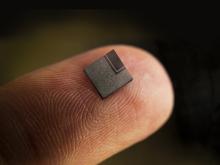- Support portal
- Evaluation Kits and partner products
u-blox Support
- Product documentation
Documentation
- Investor relations
Investor relations
Insights
|
16 Apr 2019
Seven reasons why Bluetooth is perfect for the Industrial IoT
Most of us use Bluetooth in some form every day, usually to link up things like our phones, smartwatches, headsets, mice and keyboards. In fact, Bluetooth has become so pervasive that the Special Interest Group (SIG) that oversees the standards, has predicted there will be an incredible 5.2 billion Bluetooth device shipments by 2022.

Most of us use Bluetooth in some form every day, usually to link up things like our phones, smartwatches, headsets, mice and keyboards. In fact, Bluetooth has become so pervasive that the Special Interest Group (SIG) that oversees the standards, has predicted there will be an incredible 5.2 billion Bluetooth device shipments by 2022.
Amid all the excitement around Bluetooth in the consumer space, the fact that it’s also incredibly well-suited for smart industrial use gets less attention. We wanted to shine a light on this, so we came up with seven reasons why those designing Industrial Internet of Things (IIoT) systems and networks should consider Bluetooth as their communications backbone.
1. Bluetooth is highly immune to interference
Bluetooth has clever ways of ensuring messages reach their destinations successfully, despite using the busy 2.4 GHz ISM frequency band (which it shares with the likes of Wi-Fi and ZigBee, and others).
Adaptive frequency hopping helps ensure data successfully makes its way through the noise. Individual messages are broken into small data packets, which are sent over different channels in a pre-defined sequence, known only to the transmitting and receiving devices. As many as 1600 channel-switches can take place every second. Any data packets that don’t reach their destination correctly are re-sent, and if the problem was caused by the channel, this gets flagged up so it can be avoided in the future.
2. Bluetooth lets you operate lots of wireless devices in the same space
Several Bluetooth characteristics combine to ensure you can operate large numbers of devices in close proximity. Its short data packages – ideal for industrial measurement and control applications – only spend short periods on the airwaves. Equally importantly, Bluetooth’s automatic power control ensures data is broadcast at the strength required, so no shouting when there’s no noise. Both these factors help free up airwaves for other devices to use. Lastly – and essential when it comes to IIoT usage – Bluetooth is optimized to co-exist with Wi-Fi.
3. Bluetooth can detect and rectify bit errors
In noisy environments, or where data is transmitted over longer distances (more on this below), there’s a chance of bit errors slipping into messages. Bluetooth can detect these, and take action to avoid unreliable channels, if they’re the cause.
It can also use what’s called ‘forward error correction’ (FEC) to rectify errors once data arrives at the receiver.
4. Bluetooth can integrate with your existing industrial systems
Serial ports are widely used in industrial applications. And thanks to its Serial Port Profile (SPP), Bluetooth can fit in with your existing designs. SPP emulates a full serial interface, complete with hardware handshaking via Bluetooth. Consequently, you can replace a serial cable with a wireless Bluetooth link, with either multi-point or point-to-point operation.
5. Bluetooth's range is greater than you might think
Perhaps influenced by their experiences of Bluetooth in the consumer space, many people assume the technology only works at ranges up to a couple of meters. But Bluetooth can actually operate over much greater distances, even in harsh industrial conditions. And the latest-gen Bluetooth 5 standard supports long-range mode, which we’ve used to transmit messages up to 1.7 km. Mesh networks, where data is passed from node to node until it reaches its destination, can also help boost range, particularly in dense environments.
6. You can use Bluetooth wherever you are
The Bluetooth standard is global, meaning you can use the same device anywhere on the planet – no need to source different components for industrial facilities in different markets. What’s more, because it’s so common in smartphones and other handheld devices, you can interact with Bluetooth-enabled IIoT device using devices you probably already own.
7. With Bluetooth, security is designed in
Three inherent characteristics of Bluetooth make it an extremely secure means of sharing data wirelessly. Firstly, the adaptive frequency hopping that we talked about earlier sees the transmitter send out data on a pseudo-random sequence of channels. Only it and the receiver know which channels these are. So if someone was going to try to intercept the message, they’d need to listen on all channels, then attempt to piece together the right packets of data to form the full message.
Secondly, devices using Bluetooth 4.2 or later use a pairing mechanism that prevents in-transit data from being intercepted in man-in-the-middle attacks (LE Secure Connections).
And thirdly, Bluetooth devices can be set as ‘invisible’, meaning hackers won’t actually know they’re there. Connections are then only possible between devices that have been paired beforehand.
An incredible journey
The fact that Bluetooth is such an important part of the IoT is testament to the journey the technology has been on over the last 20 years. What was initially a means of syncing data between mobile phones, has continually evolved to meet new needs, including in the IIoT. And this is why many are now choosing it to underpin their next-generation smart industrial facilities. Will you be joining them?
If you want to learn more about Bluetooth at u-blox.
Pelle Svensson
Senior Principal Product Strategy, Product Strategy Short Range Radio, u-blox



